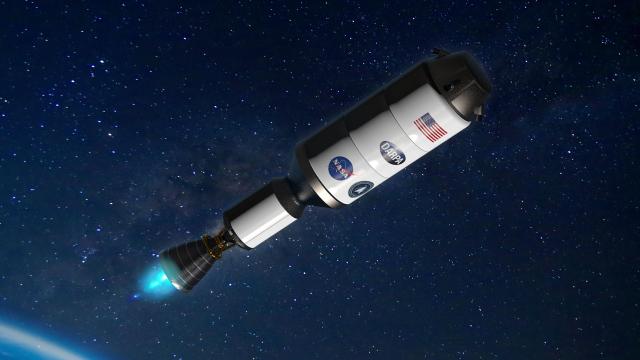One of the bigger questions surrounding NASA’s interest in sending a crewed mission to Mars surrounds the best way to get there, and it appears the agency might have found its answer. NASA announced today that it will be developing a nuclear thermal rocket engine in collaboration with the Defence Advanced Research Projects Agency (DARPA).
The collaboration is called DRACO, or Demonstration Rocket for Agile Cislunar Operations, and it’s expected to reduce the travel time it takes to get astronauts to Mars — and potentially more distant targets in deep space. According to a press release, NASA will lead technical development of the nuclear thermal engine that will be combined with an experimental DARPA spacecraft. The two agencies will further collaborate on combining the rocket with the spacecraft ahead of its demonstration in space as early as 2027.
“Our intent is to lead and develop a blueprint for human exploration and sustained presence in the solar system,” said NASA deputy administrator Pam Melroy in a NASA fireside chat this morning. “DRACO will be a critical part of evaluating the technologies that will take us deeper into the solar system.”
The last time nuclear thermal engine tests were conducted in the U.S. was more than 50 years ago, according to NASA. The engine will see a fission reactor generate high temperatures to heat a liquid propellant, which then expands and is ejected through a nozzle to propel the spacecraft. NASA says that the nuclear thermal engine could be three or more times more efficient than traditional chemical propulsion.
Reducing travel time to Mars and other locations in the solar system will subsequently reduce the amount of supplies needed for transit, which in turn can free up space for additional scientific payloads and more efficient communications equipment, NASA says. Melroy also explained that faster trips are safer trips since astronauts will spend less time being pelted by cosmic radiation while moving through space.
“When you think about national security, manoeuvrability is one of the things that everybody operating in air, on land, on sea, under sea really, really prizes, and its a capability that we don’t have enough of yet in the space environment,” said Stefanie Tompkins, director of DARPA, in the fireside chat.
NASA and DARPA’s timeline of a 2027 in-space test gives these agencies plenty of wiggle room to fine tune the rocket technology ahead of the planned, crewed mission to Mars in the late 2030s.
More: Freaky Spiral Over Hawaii Likely Caused by SpaceX Falcon 9 Rocket
